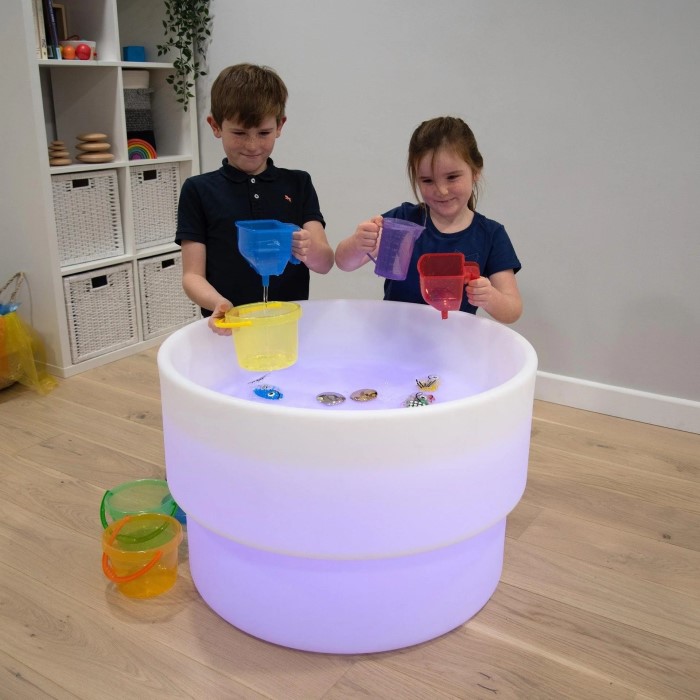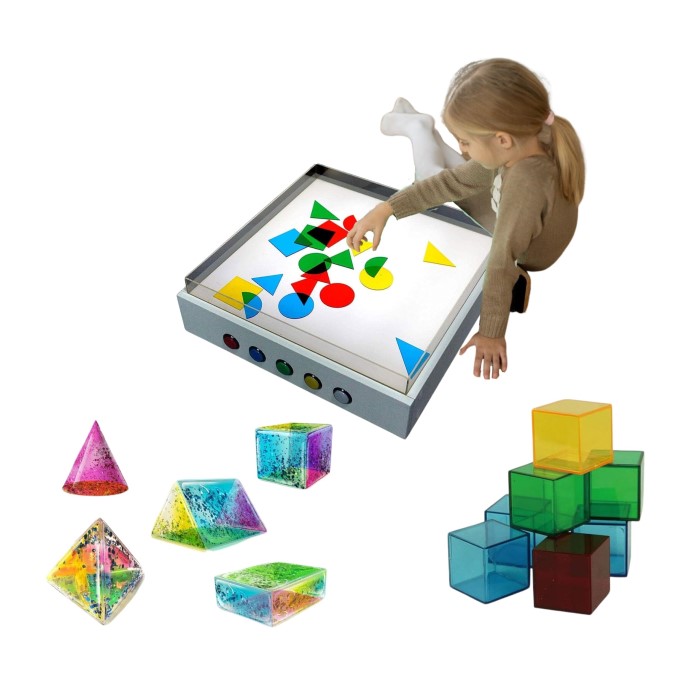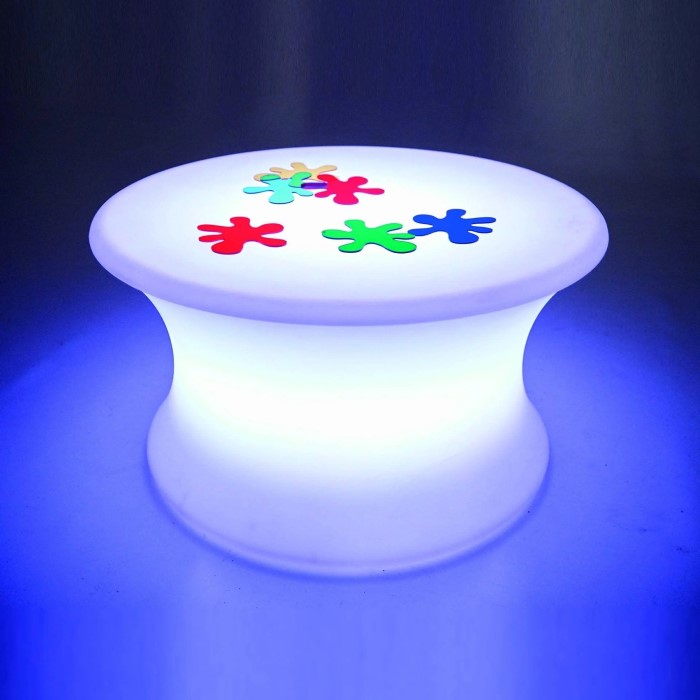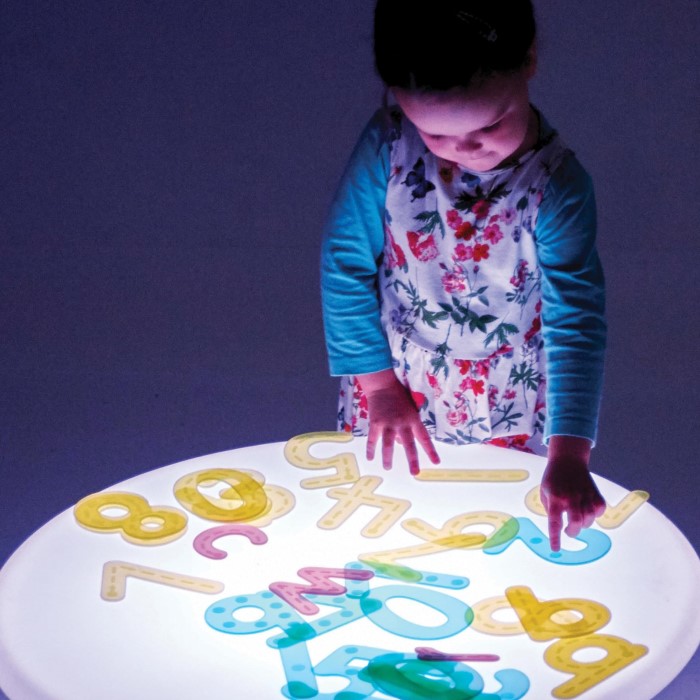Introduction
Sensory light tables are valuable tools in educational and recreational settings. These tables bring a unique way to learn and play. They combine light with tactile materials to engage kids’ senses. Let’s explore what makes them special and their many benefits.
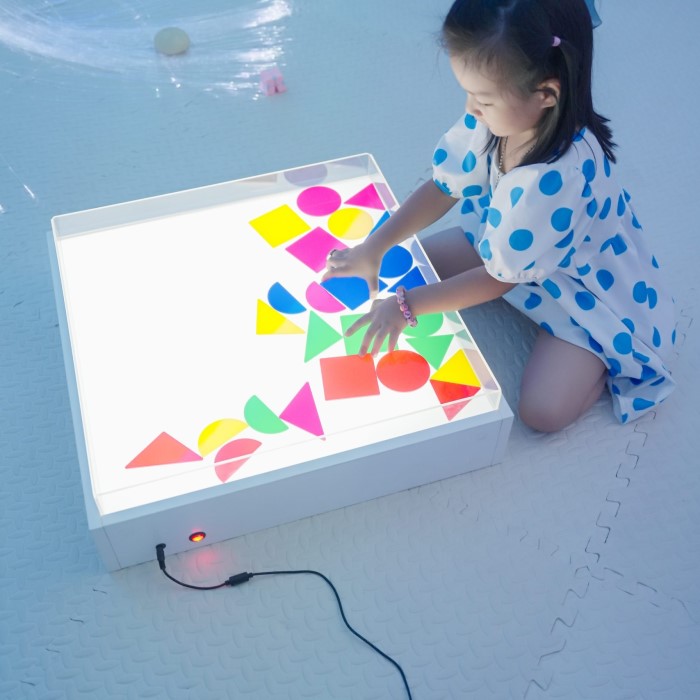
What is a Sensory Light Table?
A sensory light table is an illuminated surface designed for hands-on activities. It emits soft light from beneath, highlighting objects placed on top. Transparent, translucent, or colorful items work best. These tables encourage exploration, creativity, and sensory play. They are often used in schools, therapy centers, and homes.
Benefits of Using Sensory Light Tables
Sensory light tables offer numerous advantages for children and adults alike:
- Encourages Sensory Exploration: The light enhances visuals and textures, boosting sensory experiences.
- Supports Cognitive Development: They aid problem-solving and critical thinking during play.
- Fosters Creativity: Children use their imagination while creating patterns or light-based art.
- Improves Focus: The bright yet soothing light captures attention and reduces distractions.
- Enables Inclusive Play: They are excellent tools for kids with special needs, supporting sensory integration.
Using sensory light tables can make learning both fun and meaningful.
Setting Up
Setting up a sensory light table can be both educational and fun. With proper preparation, it becomes a valuable learning tool. Here’s a step-by-step guide to ensure the best experience.
Choosing the Right Sensory Light Table
Picking the perfect sensory light table depends on your needs and space. Consider the following:
- Size and Portability: Small tables work well for compact spaces. Larger tables suit group activities. Portable options let you move the table easily.
- Durability: Look for a sturdy build, especially if children are using it daily.
- Brightness Levels: Adjustable lighting lets you tailor the experience based on activities or sensitivity levels.
- Budget-Friendly Options: Explore various styles and brands to find affordable yet high-quality tables.
Ensure the table complements your intended use, whether it’s for play, learning, or therapy.
Essential Materials and Tools
Equipping your sensory light table with the right materials boosts creativity and learning. Gather items such as:
- Transparent and Translucent Objects: Use items like colored counters, acrylic shapes, and plastic letters.
- Natural Materials: Incorporate leaves, feathers, and rocks for themed activities.
- Crafts Supplies: Enhance play with glass beads, tissue paper, and markers.
- Interactive Tools: Add magnifying glasses or mirrors for light reflection experiments.
Organize these materials well for easy access during activities.
Safety Tips for Using a Light Table
Safety should always be a priority when using a sensory light table. Follow these tips:
- Proper Supervision: Always watch children during use to avoid mishandling or accidents.
- Use Non-Toxic Materials: Ensure all items on the table are child-safe and non-toxic.
- Check Lighting Levels: Avoid overly bright settings that strain the eyes.
- Stable Placement: Place the table on a solid surface to prevent tipping or sliding.
By following these guidelines, you can ensure a safe and productive sensory experience for everyone.
Interactive Activities for Kids
Sensory light tables provide endless opportunities for interactive and engaging activities for children. These activities harness light to foster learning and creativity through hands-on exploration.
Learning and Play with Light Reflection
Light reflection activities on sensory light tables introduce children to basic science concepts. Here are some ideas:
- Mirror Experiments: Place mirrors on the table to reflect light. Let kids observe and move the mirrors.
- Prism Exploration: Use prisms to create rainbows. Teach kids how light interacts with transparent objects.
- Shadow Play: Encourage children to place objects on the table and observe shadows. Discuss shapes and sizes.
- Magnifying Glass Fun: Add magnifying glasses to the table for close-up exploration of different materials or objects.
These activities enhance problem-solving and critical thinking while making learning entertaining.
Exploring Colors and Shapes
Sensory light tables are perfect for teaching colors and shapes. Use colorful and translucent objects to maximize the experience:
- Color Mixing: Provide colored cellophane sheets for kids to layer and mix colors. Show primary and secondary colors.
- Shape Sorting: Offer acrylic shapes or blocks for sorting by size, shape, or color.
- Stained Glass Art: Let children create designs using colorful tissue paper or plastic shapes.
- Counting and Matching: Use colored counters or letters for counting games or matching by color.
These activities build foundational skills like color recognition, sorting, and pattern creation while encouraging creativity.
Educational Applications
Sensory light tables are more than just play tools. They offer great educational value. By combining light with engaging materials, these tables support several learning pathways for children.
Enhancing Fine Motor Skills
Sensory light tables help improve fine motor skills through hands-on activities. Children practice picking, placing, and arranging small items. For example:
- Sorting Beads: Kids can sort beads by size or color, strengthening their hand muscles.
- Tracing Letters: Use stencils or templates for kids to trace letters or numbers with fingers.
- Pattern Building: Let children create patterns using small objects like seeds or counters.
- Tweezers Play: Provide tools like tweezers to pick and move objects, enhancing coordination.
These exercises help children develop precision and control in their hand movements.
Supporting Early Literacy and Numeracy Development
A sensory light table is a fantastic tool for learning literacy and numeracy. Activities may include:
- Letter Recognition: Use translucent letters to teach kids to identify and arrange them to form words.
- Number Games: Provide transparent numbers and encourage counting or simple addition and subtraction.
- Word Building: Kids can form short words using colorful letters, boosting vocabulary and spelling.
- Sorting and Sequencing: Engage kids in sorting numbers or letters in the correct order.
These activities set a strong foundation for reading, writing, and math.
Stimulating Creativity and Imagination
Creativity thrives on sensory light tables. They let children explore and express artistic ideas. Here are a few creative activities:
- Art with Colors: Kids can design images with colorful translucent tiles or paper.
- Storytelling with Shapes: Use shapes to create scenes or characters and build unique stories.
- Themed Designs: Introduce themes like space or underwater and let kids build related visuals.
- Layering Effects: Provide layers of transparent materials to create beautiful textures and patterns.
These activities encourage kids to think outside the box and unleash their imagination.
With guided use, sensory light tables become versatile tools for education and fun.
Therapeutic Uses
Sensory light tables are not just for play and education; they also serve therapeutic purposes. Designed to engage the senses, they offer a calming and stimulating environment. These attributes make them especially beneficial for individuals with special needs and for stress relief.
Benefits for Children with Special Needs
Sensory light tables provide unique benefits for children with special needs. They aid in sensory integration and enhance learning opportunities.
- Promoting Sensory Stimulation: The glowing light amplifies textures and colors, helping kids explore their senses.
- Encouraging Focus: The soft light draws attention and holds it, reducing external distractions.
- Improving Motor Skills: Activities like sorting beads or arranging shapes enhance hand-eye coordination.
- Building Communication Skills: Pairing sensory play with verbal instructions fosters language and social interaction.
- Creating Safe Zones: A sensory light table creates a safe, controlled space for children to explore without stress.
These tables serve as excellent tools for occupational and speech therapy.
Relaxation and Stress Reduction Techniques
Beyond learning, sensory light tables offer relaxation and stress relief for kids and adults.
- Calming Visuals: The soft, glowing light helps relax the mind and ease anxiety.
- Mindful Play: Gentle activities like arranging translucent tiles encourage mindfulness and reduce mental strain.
- Breathing Exercises: Using the light table, pair purposeful deep breathing with creative play for added relaxation.
- Stress-Free Creativity: Drawing or creating designs with light prompts stress release in a safe manner.
- Mood Uplift: Bright, soothing light improves mood, especially during gloomy or overstimulating days.
In therapy settings or homes, sensory light tables offer peace and comfort for users of all ages.
Seasonal and Themed Ideas for Light Tables
Sensory light tables can be adapted for seasonal and themed activities. These ideas enhance engagement and learning. By using specific materials and themes, you can create exciting experiences for kids.
Holiday-Themed Activities
Holiday-themed activities on sensory light tables bring festivities to life. Here are some ideas:
- Christmas Light Play: Use transparent ornaments and colored tissue paper to create holiday designs.
- Halloween Shadows: Provide spooky shapes like bats or pumpkins for shadow exploration.
- Valentine’s Day Art: Use heart-shaped objects or pink and red translucent materials for creative patterns.
- Easter Egg Hunt: Place colored eggs on the table for sorting or counting games.
- Fourth of July Glow: Use star-shaped items and red, white, and blue materials to design patriotic visuals.
Holiday-themed activities help children connect with traditions while exploring creativity.
Incorporating Nature and Seasonal Changes
Nature-inspired activities introduce kids to seasonal changes and environmental exploration. Try these ideas:
Autumn Leaves
- Using Real or Plastic Leaves: Gather a variety of real or artificial leaves for this seasonal activity. Real leaves can be collected during a nature walk, while plastic leaves can be easily purchased or made from craft materials.
- Creating Fall Designs: Arrange the leaves in different patterns and designs on the light table. Children can experiment with overlapping leaves, creating collages, or arranging them by color. This activity not only fosters creativity but also helps children learn about the colors and shapes of leaves during autumn.
Winter Snowflakes
- Translucent Snowflake Shapes: Provide children with various snowflake shapes made from translucent materials. Craft stores often sell pre-made snowflake templates, or you can create your own using clear plastic or acetate.
- Arranging and Tracing Activities: Invite children to arrange the snowflakes into unique patterns on the light table. They can also use the snowflakes as templates to trace their designs onto paper. This helps refine their motor skills while encouraging artistic expression and creativity.
Spring Flowers
- Incorporating Flowers and Petals: Collect real flowers or use artificial flower shapes and petals. Children can use different types of flowers to explore a variety of colors, shapes, and sizes.
- Creating Colorful Spring Patterns: Arrange the flowers and petals on the light table to form beautiful spring patterns. Children can experiment with symmetry, color combinations, and design layouts, enhancing their understanding of nature and fostering their artistic skills.
Summer Ocean Scene
- Adding Shells and Translucent Blue Materials: Gather seashells and translucent blue materials (like blue gel sheets or water beads) to create an ocean-themed scene.
- Making Underwater Themes: Encourage children to arrange the shells and blue materials on the light table to create a vibrant underwater landscape. They can layer materials to represent waves, sand, and marine life, stimulating their imagination and creativity while exploring ocean environments.
Weather Exploration
- Using Shapes for Weather Concepts: Provide cut-out shapes representing various weather elements, such as the sun, clouds, and raindrops. These shapes can be made from colored cardstock or craft foam.
- Discussing Weather Changes: Use the shapes on the light table to facilitate discussions about different weather conditions. Children can create weather scenes and engage in conversations about how weather changes throughout the seasons. This interactive activity encourages understanding of meteorological concepts and helps develop vocabulary related to weather.
These activities encourage kids to appreciate nature and adapt to seasonal differences.
Seasonal and themed ideas make sensory light tables more engaging and educational year-round.
Tips for Maintenance and Longevity
Proper care ensures that your sensory light table remains functional for years. Regular maintenance is simple and keeps the table safe and effective for use. Below are some tips to help you maintain and maximize the lifespan of your sensory light table.
Cleaning and Storing a Sensory Light Table
Cleaning and storing your sensory light table properly is important for hygiene and durability. Follow these steps:
- Wipe the Surface Regularly: Clean the table surface after every use. Use a soft cloth and mild cleaner.
- Avoid Harsh Chemicals: Do not use strong chemicals that might damage the light-emitting surface.
- Remove Spills Immediately: Wipe off any spills to prevent stains or damage to the table’s electronics.
- Inspect for Damage: Regularly check the table for scratches, cracks, or loose wires.
- Store in a Dry Area: Keep the table in a cool, dry space to avoid moisture damage.
- Cover When Not in Use: Use a soft cover or case to protect the table from dust and debris.
These practices help keep your light table in optimal condition.
Maximizing Its Lifespan
To ensure your sensory light table lasts longer, consider these additional tips:
- Use Appropriate Materials: Avoid placing heavy or sharp objects on the table to prevent scratches or breakage.
- Limit Continuous Use: Turn off the table after prolonged activities to prevent overheating and preserve the light source.
- Follow Manufacturer’s Instructions: Refer to the manual for specific maintenance tips and warranty information.
- Handle with Care: Always move the table carefully to avoid damaging internal components.
- Replace Worn-Out Parts: Fix or replace faulty bulbs, cords, or surfaces promptly to maintain functionality.
- Child Supervision: Supervise children during use to prevent misuse or accidents.
By maintaining your sensory light table, you ensure it remains an effective tool for learning and play.
Conclusion
In conclusion, the sensory light table is a remarkable tool that opens up countless possibilities for interactive and educational experiences. By exploring creative ways to use this versatile piece of equipment, parents and educators can facilitate fun learning opportunities that engage children’s senses, spark their creativity, and encourage essential developmental skills.
Incorporating sensory light tables into various activities can significantly enhance learning environments, from promoting sensory exploration to fostering language development. As you consider the myriad ways to utilize sensory light tables, remember that the goal is to create enjoyable experiences for children while enriching their learning journey. Embrace the possibilities and watch as the light table transforms learning into a vibrant, interactive adventure!
